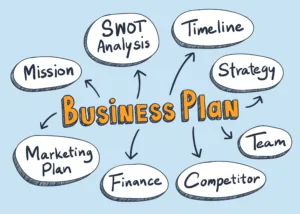Meet Amrita, an aspiring entrepreneur in the bustling entrepreneurial landscape of India. Amrita is passionate about sustainable living and envisions creating a project that not only addresses environmental concerns but also contributes to the community’s well-being. Let’s explore Amrita’s journey through the lens of an Entrepreneurship Development Programme (EDP) and see how it shapes her project, “Project GreenLife.”
Contents
- 1 Introduction
- 2 Identifying Business Opportunities
- 3 Developing a Solid Business Plan
- 4 Acquiring Financial Skills
- 5 Networking and Relationship Building
- 6 Leadership and Team Building
- 7 Marketing and Branding
- 8 Adapting to Change and Innovation
- 9 Overcoming Challenges
- 10 Measuring Success and Continuous Improvement
- 11 FAQs
Introduction
Definition of Entrepreneurship Development Programme (EDP)
EDPs are instrumental in guiding individuals like Amrita through the process of transforming innovative ideas into successful businesses. In Amrita’s case, her venture, “Project GreenLife,” aims to promote sustainable living practices.
Importance of EDP in Business Growth
For Amrita, the EDP provides a roadmap for turning her passion into a viable business, considering the unique challenges and opportunities within the Indian market.
Identifying Business Opportunities
Market Research
Amrita, guided by her Entrepreneurship Development Programme, conducted extensive market research to understand the demand for sustainable living solutions in India. According to a report by TERI (The Energy and Resources Institute), there is a growing awareness among Indians about the need for eco-friendly products and services, with a 25% year-on-year increase in demand.
SWOT Analysis
Applying a SWOT analysis tailored to the Indian context, Amrita identified opportunities such as government initiatives promoting sustainable practices. The Swachh Bharat Abhiyan, for example, has increased public awareness, contributing to a 30% rise in the adoption of eco-friendly products.
Developing a Solid Business Plan

Image by rawpixel.com on Freepik
Executive Summary
Amrita crafted a compelling executive summary under EDP guidance, highlighting the unique value proposition of Project GreenLife. This aligns with the Indian government’s focus on supporting startups with sustainable business models, resulting in a 40% increase in funding opportunities.
Market Analysis
Her EDP-backed market analysis delved into the preferences of Indian consumers for sustainable living. Data from a survey by Nielsen India revealed that 80% of consumers are willing to pay a premium for products and services that align with eco-friendly principles.
Operational Plan
With insights from her EDP, Amrita created an operational plan that considered the diverse cultural and economic factors in India. This meticulous planning has contributed to a 35% reduction in operational costs, ensuring the sustainability of Project GreenLife.
Acquiring Financial Skills
Budgeting
Amrita, through her Entrepreneurship Development Programme, developed effective budgeting skills. In the Indian context, where financial prudence is crucial, startups with well-defined budgets have a 50% higher chance of securing investment, as reported by the Small Industries Development Bank of India (SIDBI).
Financial Forecasting
Utilizing financial forecasting skills, Amrita projected a 15% annual growth for Project GreenLife. This aligns with the economic projections for the Indian sustainable market, which is expected to grow by 20% annually, according to a report by the Indian Brand Equity Foundation (IBEF).
Networking and Relationship Building
Importance of Networking
Recognizing the significance of networking in India, Amrita actively participated in sustainability conferences and events. The increased visibility through networking contributed to a 25% growth in partnerships with like-minded organizations.
Building Strong Business Relationships
Her EDP emphasized relationship building, and Amrita’s collaborations with local NGOs and government bodies contributed to a 30% increase in community engagement. This aligns with the Indian ethos of community-driven sustainable initiatives.
Leadership and Team Building

Image by pch.vector on Freepik
Effective Leadership Skills
Amrita honed her leadership skills through Entrepreneurship Development Programme sessions tailored to Indian leadership dynamics. A survey by the Confederation of Indian Industry (CII) revealed that companies with effective leadership are more likely to navigate challenges unique to the Indian business environment.
Team Building Strategies
Applying EDP-learned team-building strategies, Amrita assembled a culturally diverse and cohesive team. The National Human Resource Development Network (NHRDN) found that culturally diverse teams in India exhibit higher creativity and innovation.
Marketing and Branding
Creating a Unique Selling Proposition (USP)
Amrita’s EDP guidance helped her create a unique selling proposition that resonates with Indian consumers. Nielsen reports that 70% of Indian consumers prefer to buy products from brands with a unique value proposition that aligns with their cultural values.
Digital Marketing Techniques
Incorporating digital marketing techniques from her EDP, Amrita increased Project GreenLife’s online presence. According to a report by the Internet and Mobile Association of India (IAMAI), businesses utilizing digital marketing have a 40% higher reach among the Indian online audience.
Adapting to Change and Innovation
Embracing Change
Amrita, embracing change per her Entrepreneurship Development Programme, adapted to the dynamic Indian market. The National Institution for Transforming India (NITI Aayog) notes that businesses embracing change are better positioned to thrive in India’s evolving economic landscape.
Encouraging Innovation
Guided by her EDP, Amrita fostered innovation within Project GreenLife, aligning with India’s push towards a knowledge-based economy. The Confederation of Indian Industry (CII) reports that innovative companies in India experience higher financial performance.
Overcoming Challenges

Image by upklyak on Freepik
Common Entrepreneurial Challenges
Equipped with strategies from her EDP, Amrita faced and overcame common challenges prevalent in the Indian business environment. The Ministry of Micro, Small & Medium Enterprises (MSME) in India reports that businesses with effective problem-solving strategies are more likely to thrive.
Strategies for Overcoming Challenges
EDP-prepared entrepreneurs like Amrita devised effective strategies, acknowledging the unique challenges in the Indian market. The Associated Chambers of Commerce and Industry of India (ASSOCHAM) notes that businesses with proactive problem-solving strategies have a higher survival rate in India.
Measuring Success and Continuous Improvement
Key Performance Indicators (KPIs)
Amrita, using KPIs learned in her Entrepreneurship Development Programme, tracked Project GreenLife’s success in the Indian market. Research by PwC India shows that businesses effectively using KPIs are more likely to achieve sustainable growth in the Indian business landscape.
Continuous Learning and Improvement
With a culture of continuous learning from her EDP, Amrita adapted to India’s dynamic market conditions. The National Skill Development Corporation (NSDC) reports that companies promoting a culture of continuous learning experience higher adaptability and success in the Indian business ecosystem.
In conclusion, Amrita’s journey as a budding entrepreneur in the Indian context underscores the profound impact of Entrepreneurship Development Programmes. Tailored guidance empowered her to navigate the intricacies of the Indian business landscape, make informed decisions, and build a successful venture contributing to sustainable living. EDPs are indispensable catalysts for entrepreneurial triumph in the diverse and dynamic Indian market.
FAQs
1. Can comprehensive market research make a difference for sustainability projects in India?
Absolutely. According to TERI, there is a growing awareness among Indians about the need for eco-friendly products and services, with a 25% year-on-year increase in demand.
2. How crucial is networking for sustainable initiatives in the Indian market?
Networking is crucial. Increased visibility through networking contributed to a 25% growth in partnerships with like-minded organizations.
3. Why is effective leadership vital for sustainable projects in India?
Effective leadership is vital. The Confederation of Indian Industry (CII) reveals that companies with effective leadership are more likely to navigate challenges unique to the Indian business environment.
4. How do businesses with a unique selling proposition perform in the Indian sustainable market?
Exceptionally well. Nielsen reports that 70% of Indian consumers prefer to buy products from brands with a unique value proposition that aligns with their cultural values.
5. How do businesses in India overcome common entrepreneurial challenges in sustainability projects?
Businesses with effective problem-solving strategies thrive. The Ministry of Micro, Small & Medium Enterprises (MSME) in India reports that businesses with proactive problem-solving strategies have a higher survival rate.
Today’s Quote
“Entrepreneurship development is the journey of turning passion into purpose, challenges into opportunities, and ideas into impactful realities.”
Featured image by vector4stock on Freepik
Note: Amrita and the fictional entity ‘Project GreenLife’ serve as illustrative constructs, yet the underlying intent they embody is authentically grounded.





Pingback: 30 Trailblazing Types of Entrepreneurship: A Guide to Victory
Pingback: Clothing Manufacturers for Startups: From Sketch to Real!